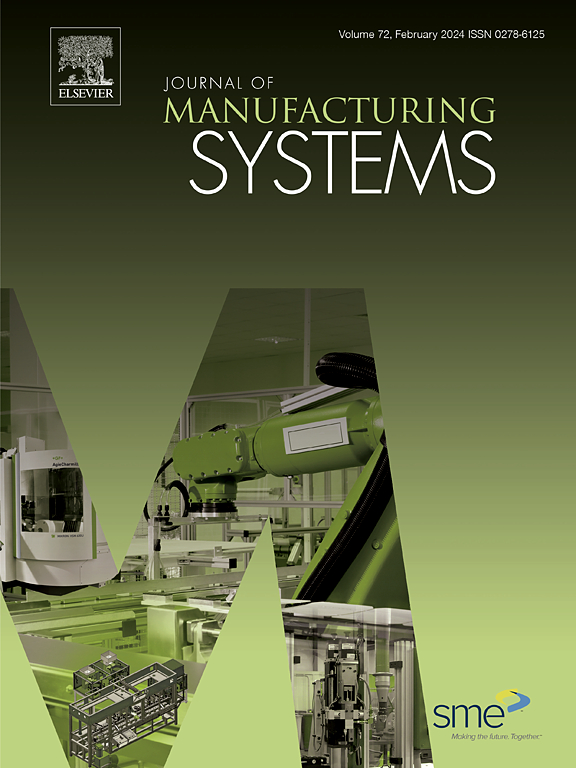基于卷积自编码器和结构相似性的绕线转子同步电机生产视觉异常检测
IF 12.2
1区 工程技术
Q1 ENGINEERING, INDUSTRIAL
引用次数: 0
摘要
制造用于电动汽车牵引系统的绕线转子同步电机(wrsm)需要严格的质量检查,以确保最佳的产品性能和效率。本文提出了一种基于卷积自编码器(cae)和结构相似指数(SSIM)的无监督学习视觉异常检测方法,用于监测wrsm的绕针过程。该方法在绕线过程的每个阶段确定与期望的正环绕线模式的偏差,从而能够早期发现绕线错误,防止资源浪费和对产品或绕线机械的潜在损坏。轨迹同步帧提取使视觉检测系统与卷绕轨迹对齐,确保在卷绕过程中精确监测到特定点。我们提出了一个综合的绕组异常数据集(WAD),该数据集包括在不同光照条件下记录的有绕组故障和无绕组故障的WRSM转子原型图像。所提出的基于重构的异常检测技术仅在无故障数据上进行训练,并利用引入的屏蔽平均结构不相似指数度量(MMSDIM)在推理过程中聚焦于绕组的相关部分。综合对比分析表明,具有非正则化潜空间的CAE和最大平均差异的Wasserstein自编码器(MMD-WAE)在异常检测性能方面优于beta变分自编码器(beta- vae), CAE和WAE的结果相当。大量的测试证实了该方法的有效性,在100%精确的情况下,召回率达到95.6%,AUROC达到99.9%,在具有挑战性的WAD上,平均精度达到99.1%,大大优于最先进的视觉异常检测模型。因此,这项工作为WRSM生产质量监控提供了一个强大的解决方案,并促进了电气驱动制造系统中视觉检测的结合。本文章由计算机程序翻译,如有差异,请以英文原文为准。

Reconstruction-based visual anomaly detection in wound rotor synchronous machine production using convolutional autoencoders and structural similarity
Manufacturing wound rotor synchronous machines (WRSMs) for electric vehicle traction systems necessitates rigorous quality inspection to ensure optimal product performance and efficiency. This paper presents a novel visual anomaly detection method for monitoring the needle winding process of WRSMs, utilizing unsupervised learning with convolutional autoencoders (CAEs) and the structural similarity index measure (SSIM). The method identifies deviations from the desired orthocyclic winding pattern during each stage of the winding process, enabling early detection of winding errors and preventing resource wastage and potential damage to the product or winding machinery. Trajectory-synchronized frame extraction aligns the visual inspection system with the winding trajectory, ensuring precise monitoring traceable to a specific point in the winding process. We present the comprehensive Winding Anomaly Dataset (WAD), which comprises images of WRSM rotor prototypes with and without winding faults recorded in different lighting conditions. The proposed reconstruction-based anomaly detection technique is trained on fault-free data only and utilizes the introduced masked mean structural dissimilarity index measure (MMSDIM) to focus on the relevant sections of the winding during inference. Comprehensive comparative analysis reveals that the CAE with unregularized latent space and the maximum mean discrepancy Wasserstein autoencoder (MMD-WAE) outperform the beta variational autoencoder (beta-VAE) in terms of anomaly detection performance, with the CAE and WAE delivering comparable results. Extensive testing confirms the approach’s effectiveness, achieving 95.6 % recall at 100 % precision, an AUROC of 99.9 %, and an average precision of 99.1 % on the challenging WAD, considerably outperforming state-of-the-art visual anomaly detection models. This work thus offers a robust solution for WRSM production quality monitoring and promotes the incorporation of visual inspection in electric drive manufacturing systems.
求助全文
通过发布文献求助,成功后即可免费获取论文全文。
去求助
来源期刊

Journal of Manufacturing Systems
工程技术-工程:工业
CiteScore
23.30
自引率
13.20%
发文量
216
审稿时长
25 days
期刊介绍:
The Journal of Manufacturing Systems is dedicated to showcasing cutting-edge fundamental and applied research in manufacturing at the systems level. Encompassing products, equipment, people, information, control, and support functions, manufacturing systems play a pivotal role in the economical and competitive development, production, delivery, and total lifecycle of products, meeting market and societal needs.
With a commitment to publishing archival scholarly literature, the journal strives to advance the state of the art in manufacturing systems and foster innovation in crafting efficient, robust, and sustainable manufacturing systems. The focus extends from equipment-level considerations to the broader scope of the extended enterprise. The Journal welcomes research addressing challenges across various scales, including nano, micro, and macro-scale manufacturing, and spanning diverse sectors such as aerospace, automotive, energy, and medical device manufacturing.
 求助内容:
求助内容: 应助结果提醒方式:
应助结果提醒方式:


